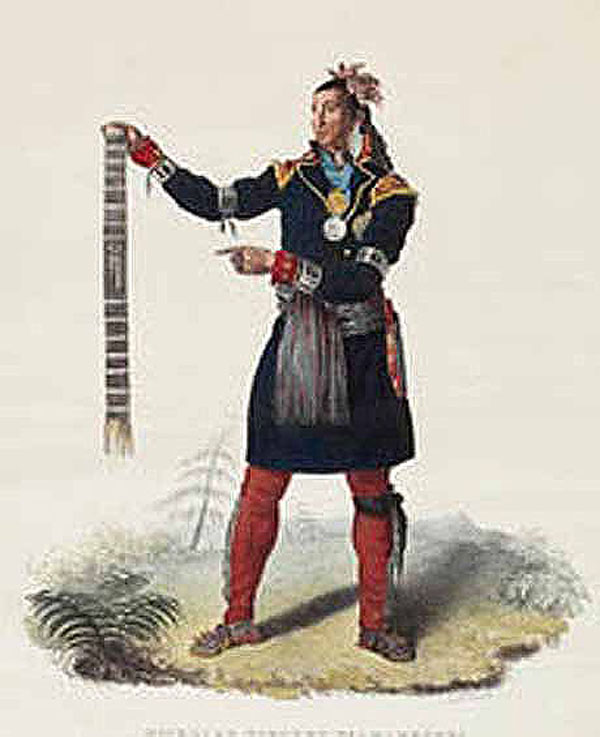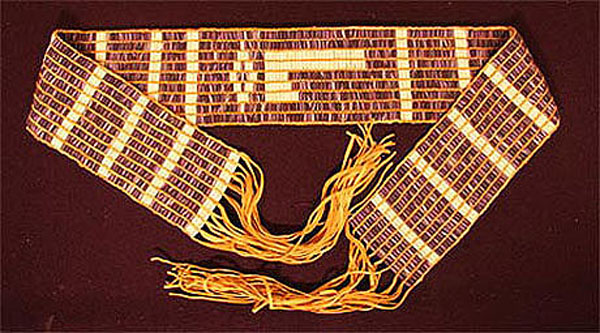 |
Photographs (left to right): Conesus Lake, New York; Suwannee River Park, Florida; Monhonk, New York
Wampum Belt Archive
Huron Wendat Alliance Belt

Original (McCord Museum)
MCM M20401
Reproduction R. D. Hamell Oct. 20 2008
Original Size: |
Length: 47.2 inches. Width: 2.8 inches. Rows: 9. |
Reproduction: |
Beaded length: 44.5 inches. Width: 4.25 inches. Total length with fringe: 66.5 inches. |
Beads: |
Rows: 252 by 9 beads wide. Total 2,268 beads. |
Materials: |
Warp: leather. Weave: leather. |
Description:
This belt called 'Bury the Hatchet' belt is shown in the painting of Tsawenhohi in the McCord Museum, 690, rue Sherbrooke Ouest, Montréal (Québec) H3A 1E9, Téléphone : (514) 398-7100.
'St Regis-Caughnawaga, Mohawk Wolf Belt, and this belt have been associated with the Great Peace Council held at Kahnawake in Montreal ending the French and Indian War ca 1760. (Bonaparte, 2012).
 |
 |
Axe has traces of red paint, said to be of the Great Peace of Montreal in 1701.
Gift of Mrs. Walter M. Stewart, redrawn and described by Samuel Doughlas Smith Huygue at the archie of the Huron-Wendat at Lorette, present Wendake in 1846 as "The Great War Belt.
Reference:
Bonaparte, Darren. 2012. Personal Communications.Also see WampumChronciles: http://www.wampumchronicles.com/

The belt resides in their collection Cat. # M20401. Date: 1755-1760. "In the early 17th century, the Hurons (who called themselves Wendats, or "island dwellers") lived in the Great Lakes region. There they formed a nation comprising 20 to 25 villages, where they practiced farming, hunting and fishing. Located at a crossroads of trade routes, the Wendats became indispensable middlemen in the fur trade and the main suppliers to the French. Their strategic position was coveted by other Iroquois groups. Over more than 10 years the Iroquois, supported by the Dutch, tried to disrupt trade and expand their fur supply sources. Finally defeated in 1650, the Huron-Wendat dispersed. One group took refuge at Québec City, and in 1697 it at last settled on what would become Old Wendake.
Oral tradition suggest this belt represents a clause in the great treaty which ended the French and Iroquois wars in 1701 (McCord).
The Historic Sites and Monuments Board of Canada has also recognized other contributions of this Wendat community to Canada's history. In 1999, it designated Old Wendake a historic district, and in 2000 it designated Grand Chief Ignace-Nicolas Vincent Tsawenhohi (1769–1844) a person of national historic importance. Serving as Grand Chief from 1811 to 1844, Tsawenhohi ("he who sees clearly") was a respected politician and a renowned diplomat who asserted the territorial rights of his nation. He was appreciated for his deeds as well as his knowledge of Aboriginal law, customs and tradition. His legacy to his community was a strong sense of pride."
Reference:
McCord Museum - http://www.quebec400.gc.ca/histoires-stories/huron-wendat-eng.cfm
 |
 |
 |
 |
 |
 |
 |
 |
|---|
